
Acer heldreichii is a species of maple in the flowering plant family Sapindaceae. Commonly called Balkan maple, Greek maple, Heldreich's maple, or mountain maple the species is native to Albania, Bulgaria, Greece, North Macedonia, Montenegro, Serbia, and Bosnia-Herzegovina.

Protea magnifica, commonly known as the queen protea, is a shrub, which belongs to the genus Protea within the family Proteaceae, and which is native to South Africa.

Protea effusa, sometimes known as the scarlet sugarbush, is a flowering plant which belongs to the genus Protea. The plant is endemic to the Western Cape province of South Africa. In the Afrikaans language the vernacular name blosrooisuikerbos has been recorded for this plant.

Protea namaquana, also known as the Kamiesberg sugarbush, is a flowering plant which belongs to the genus Protea. The plant is endemic to the southwestern Cape Region of South Africa, in particular the Kamiesberg mountains of Namaqualand in the Northern Cape province. The species has a worldwide distribution of only 18 km2. It is regarded as critically endangered. In the Afrikaans language it has the vernacular name is Kamiesbergsuikerbos.

Protea intonsa, also known as the tufted sugarbush, is a flowering plant of the genus Protea within the family Proteaceae, endemic to South Africa, where it is distributed from the eastern Swartberg and Kammanassie Mountains to the Baviaanskloof mountains. In Afrikaans it is known as klossie-suikerbos.
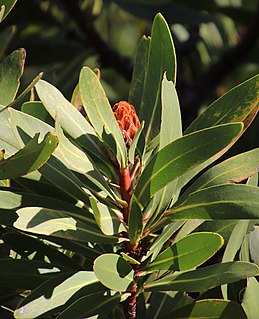
Protea rubropilosa, also known as the Transvaal sugarbush, escarpment sugarbush or Transvaal mountain sugarbush, is a flowering tree, that belongs to the genus Protea in the family Proteaceae. The plant only occurs in South Africa.

Protea pudens, also known as the bashful sugarbush, is a low-growing, groundcover-like, flowering shrub in the genus Protea. It is only found growing in the wild in a small area in the Western Cape province of South Africa.
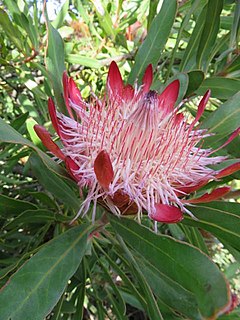
Protea susannae, also known as stink-leaf sugarbush, is a flower-bearing shrub of the genus Protea. The plant is endemic to the southwestern Cape Region of South Africa.

Protea lorifolia, in English called the strap-leaved sugarbush, strap-leaved protea or strap-leaf sugarbush is a flowering shrub which belongs to the genus Protea.
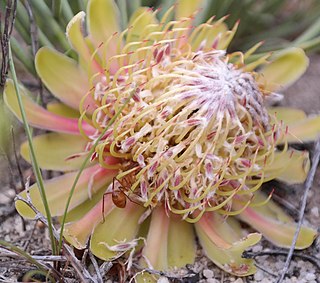
Protea revoluta, also known as the roll-leaved sugarbush or rolled-leaf sugarbush, is a species of plant which is classified in the genus Protea. P. revoluta is only found growing in the wild in South Africa, where plants can be found growing between the Cederberg inland on the Atlantic coast and the Witteberg area to the north.
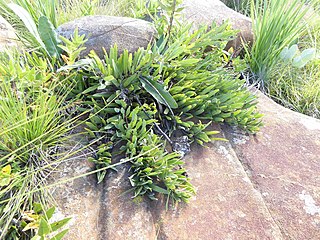
Protea parvula, also known as the dainty sugarbush, or kleinsuikerbos in Afrikaans, is a small flowering shrub belonging to the genus Protea.

Protea caespitosa, also known as hottentot bishop sugarbush or bishop sugarbush, is a flowering shrub belonging to the genus Protea which is only found growing in the wild in South Africa.

Protea punctata, also known as the water sugarbush or water white sugarbush, is a shrub belonging to the genus Protea which is found growing in the wild in South Africa.

Protea subulifolia, the awl-leaf sugarbush, is a flower-bearing shrub belonging to the Protea genus. The plant is native to the Western Cape and occurs from the Stettynskloof to Riviersonderendberge, Langeberg, Bot River to the Elim plain. The plant grows 50 cm in diameter and 70 cm tall and flowers from July to September.
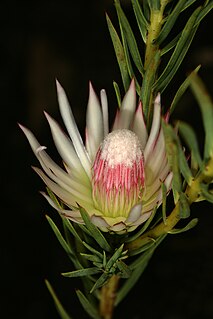
Protea mucronifolia, the dagger-leaf sugarbush, is a flower-bearing shrub belonging to the Protea genus. The plant is endemic to the Western Cape where it occurs from Hermon to Saron. This is the only population. The shrub grows upright and grows 1 m tall and flowers from October to January with the peak from November to December.

Paranomus longicaulis, commonly known as exploding baked apple and woolly sceptre, is a flower-bearing shrub that belongs to the genus Paranomus and forms part of the fynbos. The plant is native to the Western Cape where it occurs on the eastern Langeberg from Garcia Pass to the Attakwaskloof.

Paranomus roodebergensis, known as the honey-scented sceptre, is a flower-bearing shrub that belongs to the genus Paranomus and forms part of the fynbos. The plant is native to the Western Cape, where it occurs in the Rooiberg, Huis River Pass and Touwsberg.

Paranomus spathulatus, the Langeberg sceptre, is a flower-bearing shrub that belongs to the genus Paranomus and forms part of the fynbos. The plant is native to the Western Cape, South Africa.

Paranomus bolusii, the Overberg sceptre, is a flower-bearing shrub that belongs to the genus Paranomus and forms part of the fynbos. The plant is native to the Western Cape where it occurs on the Groenlandberg, Riviersonderendberge, Babilonstoringberge and Kleinrivierberge, Caledon and the Swartberg.
Paranomus candicans, the powder sceptre, is a flower-bearing shrub that belongs to the genus Paranomus and forms part of the fynbos. The plant is native to the Western Cape where it occurs in the Hex River Mountains up to the Langeberg.



















